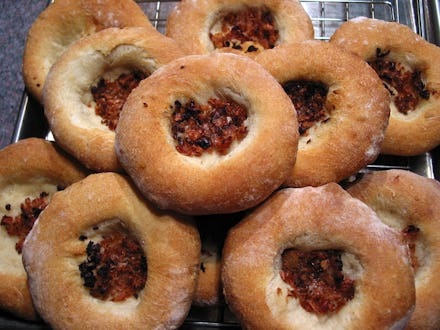Here's Why Bialys Are Better Than Bagels

The only thing better than a freshly baked bagel is a freshly baked bialy. While it's easy to confuse the two — a bialy looks like a smaller, thinner bagel without a complete hole in the middle — the two couldn't be less alike.
"A bialy is actually more closely related to an English muffin than a bagel," said Evan Giniger, co-owner of Kossar's, a legendary Jewish bakery in New York City that's been around since 1936.
Bialy who? A bialy (pronounced bee-ah-lee) is a "very simple piece of bread," Giniger said. Flour, water, salt and yeast are folded into a dough and left to rise. Once the dough has risen, it's shaped into bialy form and baked in an oven.
Bagels, on the other hand, are much more complicated to make. "A bagel has all of the same base ingredients as a bialy but it also has a sugar component to the dough, which is often malt syrup," Giniger said. Once the dough is made, it needs to be refrigerated for 24 hours to "slow down the rising process and combine all the flavors." The next day, the dough is shaped, boiled and baked.
While the cooking processes are drastically disparate, the most glaring difference between a bialy and a bagel is that the former does not have a bagel's signature hole. Instead, it has an indentation that is typically filled with a savory filling poppy seeds or garlic, Giniger said, but the most classic version features roasted onions.
Some bialy folklore: While there is no confirmed explanation as to how the bialy got its distinctive dent, Giniger offered up an origin story rooted in folklore. One day a baker in Bialystok, Poland — where the bialy was invented — was making bread and he "accidentally dropped the dough on the ground, stepped on it and left an indentation," Giniger said. The baker didn't feel like remaking it, so he baked it as it was, and so the bialy was born.
Bialys, which made their way to the states before bagels, came to America with the wave of Polish immigrants in the 1800s, Giniger said. Many of the immigrants set up shops, especially in New York City's Lower East Side neighborhood. "The neighborhood was littered with bialy shops. They were essentially bakeries that people would visit daily." Kossar's has been around since 1936. Bialys used to be so popular that until the mid-'80s, the shop sold nothing but the round bread.
"The neighborhood was littered with bialy shops. They were essentially bakeries that people would visit daily."
These days, Kossar's a mix of bagels, bialys and even more modern iterations of the bialy. In addition to the classics, the store offers up more playful flavors like a sun-dried tomato, olive tapenade and sweet varieties (there's even one sprinkled apples and cinnamon). And unlike the bagel, the bialy has managed to duck and escape the rainbow trend.
While they're not as popular as they once were, bialys are still preferred by many because of their size. They don't lend themselves to the gargantuan expectations that bagels have surpassed. "They are smaller so they are less calories," Giniger said with a laugh. "They are less filling too." Because they're thinner, they also make a better base for sandwiches than their bagel counterparts, Gingier said, (plus, their flavored middle means you don't have to add as many condiments).
Most people, however, prefer to keep things simple and eat a bialy "with a proper schmear of cream cheese."
Read more: